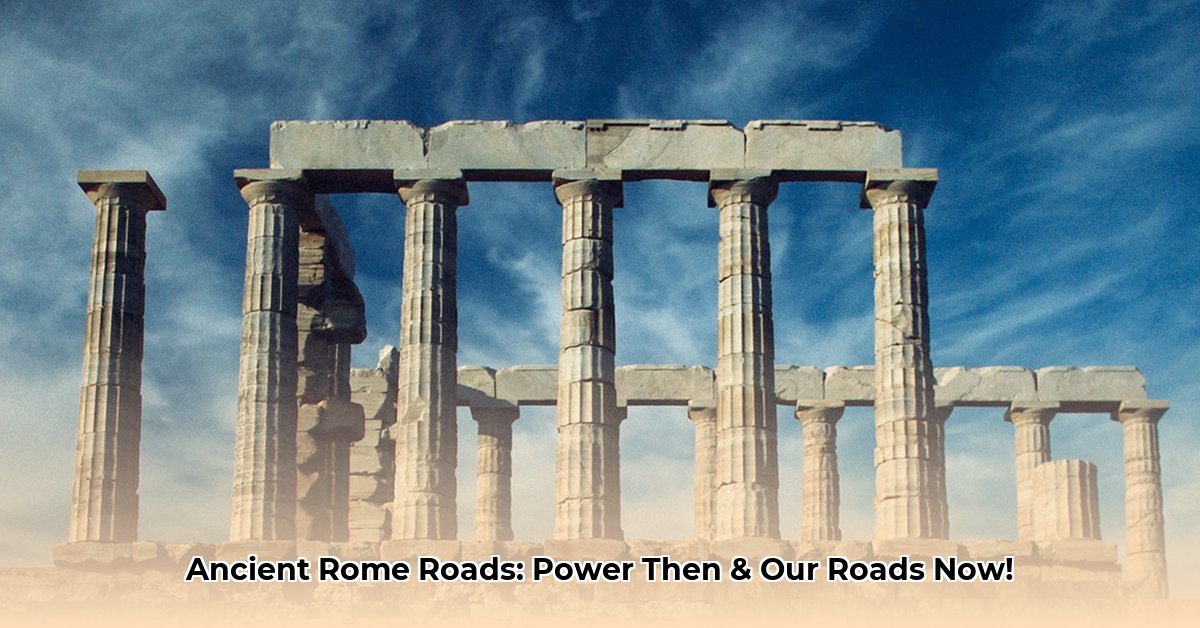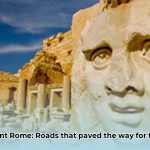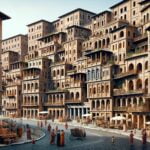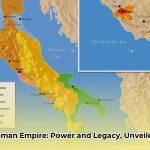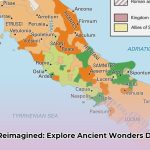The Roman Empire, a civilization renowned for its military prowess and administrative genius, owed much of its enduring success to an often-overlooked marvel: its extensive and meticulously engineered road network. These were far from simple tracks; they were sophisticated highways that facilitated the rapid mobilization of legions, ensured the smooth flow of commerce, and forged strong cultural bonds across a vast and diverse domain. Learn more about the Via Appia, a vital Roman road. Stretching over 250,000 miles (400,000 kilometers) at its peak, with approximately 50,000 miles (80,000 kilometers) paved, this intricate web connected bustling urban centers to remote outposts, from the mist-shrouded shores of Britain to the sun-baked landscapes of Syria and North Africa. It was, indeed, a breathtaking testament to Roman engineering brilliance and strategic foresight.
The Architectural Genius: How Roman Roads Were Built to Last
The remarkable durability and effectiveness of Roman roads were not accidental. They were the result of a systematic, multi-layered approach to construction, honed over centuries and executed with an precision that still impresses civil engineers today. Roman road building was a fusion of practical understanding, strategic planning, and innovative techniques.
The methodical construction process included:
-
Strategic Surveying and Route Selection: Before any digging commenced, Roman engineers, known as agrimensores, meticulously surveyed the terrain. Utilizing instruments such as the groma for establishing straight lines and right angles, and the more advanced dioptra for leveling, they charted the most direct possible routes between two points. This unwavering commitment to straightness, even across challenging geographical features like hills or valleys, underscored the Roman emphasis on efficiency and imperial control. Where direct routes were impossible, they opted for sharp turns and switchbacks rather than sweeping curves, as exemplified by Britain’s Fosse Way, which veered only a few miles off course over its entire 180-mile distance.
-
Multi-Layered Foundation: The construction was a multi-tiered undertaking designed for unparalleled strength and longevity.
- Statumen: The initial layer consisted of a trench dug and compacted with large stones, rough gravel, or even wooden piles in marshy areas, serving as a stable foundation.
- Rudus: Above this, a layer of smaller stones or crushed brick, often mixed with lime or concrete made from volcanic ash (pozzolana), was added, forming a robust sub-base.
- Nucleus: A finer layer of sand, crushed stones, or concrete was then applied, creating a solid, stable bed for the surface.
- Pavimentum (Summum Dorsum): The final surface layer featured large, tightly fitted paving stones, often made of basalt (silice), limestone, or volcanic tuff. In more prestigious urban areas, these stones could even be polished for aesthetic appeal.
-
Ingenious Drainage Systems: The Romans acutely understood the destructive power of water. To combat erosion and preserve structural integrity, roads were consistently built with a convex shape, crowned in the center and sloping slightly down to the edges. This design allowed rainwater to flow efficiently into adjacent ditches or drainage channels. In particularly rainy regions, roads were even built on raised berms, known as aggers, to prevent flooding, an early form of elevated highway.
-
Overcoming Obstacles with Engineering Marvels: To maintain their direct lines and uninterrupted transport networks, Roman engineers constructed breathtaking structures:
- Bridges and Viaducts: Massive stone-arched bridges, like the impressive Milvian Bridge in Rome (109 BCE) or the still-standing bridge over the Tagus River at Alcantara, Spain (106 BCE), spanned rivers and valleys. Some viaducts, such as the 700-meter-long, 10-arch structure over the Carapelle River, minimized lengthy detours. The bridge at Narni, an astounding 180 meters long and 33 meters high, featured four massive semicircular arches, one stretching 32.1 meters—among the longest block-arch spans in the ancient world.
- Tunnels: When mountains stood in the way, the Romans carved tunnels, often excavating from both ends (counter-excavation) with remarkable geometric precision. Notable examples include the 1,000-meter-long Cumaea tunnel and the 705-meter Cripta Neapolitano, both built in the 1st century BCE. Shafts were sometimes drilled from above to check progress and speed excavation, even as progress could be painstakingly slow—sometimes as little as 30 centimeters a day through solid rock.
Building these roads required immense coordinated labor from Roman legionaries, slaves, and local workers. The use of locally available materials, such as stone from nearby quarries, frequently reduced transport costs, while milestones (miliaria) marked distances for travelers and officials, often recording who was responsible for a road’s upkeep.
Beyond Paths: Roads as Instruments of Roman Power and Prosperity
Roman roads transcended their physical function; they were fundamental instruments of imperial power, catalysts for economic prosperity, and essential conduits for cultural exchange that shaped the ancient world.
-
Military Dominance: The primary purpose of Roman roads was military. They enabled the disciplined legions to move with astonishing rapidity, often covering as much as 20 miles a day. This swift deployment allowed Rome to respond quickly to internal uprisings and external threats across its vast territories, reducing the need for large, costly garrison units at frontier outposts. Roads like the Via Egnatia in the Balkans and Watling Street in Britain were critical military arteries.
-
Economic Engine: Roads profoundly facilitated trade and commerce. Goods—ranging from staple grains and fine wines to intricate pottery, olive oil, and luxurious textiles—traveled efficiently across the Roman Empire. This robust inter-provincial trade significantly enriched the empire and fostered robust economic connections between its distant communities. Market towns frequently sprang up along major routes, further stimulating local economies.
-
Communication Superhighway: The Roman road network effectively served as the ancient world’s most advanced communication system. The cursus publicus, the sophisticated Roman state postal service, relied entirely on these roads to deliver vital messages and official documents with astounding speed. Relay stations, known as mutationes, located every 10 miles, provided fresh horses for couriers, enabling them to travel up to 60 miles in a single day. Larger roadside hotels, mansiones, offered lodging, food, and wagon repair every 20 miles.
-
Cultural Diffusion: Beyond commerce and communication, the roads fostered a shared Roman identity. As diverse populations traveled and interacted along these routes, ideas, customs, languages, and even religious beliefs (including the spread of early Christianity) disseminated rapidly, contributing to the cultural unification and Romanization of the varied peoples under Roman rule.
-
Symbols of Authority: Major roads often began or ended with grand triumphal arches, serving as powerful affirmations of Roman power and imperial prestige. Roads were frequently named after the magistrates who funded them, such as the famous Via Appia, named after Censor Appius Claudius Caecus. These colossal public works were tangible physical manifestations of Roman authority, solidifying control over newly conquered lands and provinces.
Different types of roads served specific functions within this vast network:
* Viae Publicae: Public roads financed by the state, forming the backbone of the empire’s main arteries.
* Viae Privatae: Private roads maintained by individuals or estates.
* Viae Militares: Roads designed primarily for the rapid movement of armies and supplies.
* Viae Vicinales: Local roads connecting villages and rural areas, integrated into the broader network.
| Function | Benefit |
|---|---|
| Military Deployment | Enabled swift legion movements, facilitating rapid responses to threats and ensuring firm control over vast territories. |
| Trade & Commerce | Ensured efficient transportation of goods and resources, stimulating economic growth and connecting disparate regions. |
| Imperial Communication | Allowed for rapid dissemination of vital information and official decrees, crucial for effective governance across the Empire. |
| Cultural Diffusion | Facilitated the exchange of ideas, customs, and technologies, fostering a strong sense of shared Roman identity. |
| Consolidation of Power | Served as a tangible physical manifestation of Roman authority, solidifying control over newly conquered lands and provinces. |
An Enduring Blueprint: Roman Roads in the Modern World
The legacy of Roman roads resonates profoundly in our modern world. Many contemporary highways, astonishingly, trace or directly overlay the very routes established by the Romans. For example, Italy’s Strada Statale 7 closely follows the ancient Via Appia, and in Britain, major routes like the A1 and A5 align with Roman roads such as Dere Street and Watling Street. Some Roman bridges, like those at Tre Ponti, still carry continuous road traffic today, over two millennia after their initial construction.
This persistence stands as a powerful testament to the Romans’ unparalleled understanding of topography, their selection of optimal pathways for travel, and their pioneering engineering principles. Their enduring emphasis on direct routes, highly durable materials, layered foundations, and effective drainage systems continues to inspire road builders and civil engineers worldwide. The very concept of a unified transportation network—supporting commerce, administration, and defense—remains a core feature of global infrastructure planning, directly mirroring Rome’s ancient blueprint.
Roman roads are more than mere historical artifacts; they are timeless reminders of an ancient genius whose impact still shapes how nations connect and prosper. Whether it is the layout of European motorways or the systematic approach to American highways, the echoes of Roman expertise reveal how ancient ingenuity continues to guide modern infrastructure development.
Frequently Asked Questions
Did the Romans invent roads?
No, the Romans did not invent roads. However, they drastically perfected and expanded upon earlier road concepts dating back to the Bronze Age, creating an unprecedentedly sophisticated, vast, and durable network.
What was the first major Roman road?
The first great Roman road was the Via Appia (Appian Way), constructed starting in 312 BCE under Censor Appius Claudius Caecus. Known as the “Queen of Roads” (Regina viarum), it initially linked Rome to Capua in a nearly straight 196-kilometer (132-Roman-mile) route. It was later extended to Brundisium, totaling 569 kilometers (385 Roman miles).
What were some other famous Roman roads?
Other notable Roman roads include the Via Flaminia (Rome to Fano), the Via Aemilia (Placentia to Aosta), the Via Domitia (French Alps to Pyrenees), and the Via Egnatia (crossing the Balkan Peninsula to Byzantium, a vital link between the western and eastern parts of the empire). Britain’s Fosse Way and Watling Street are also well-known examples of Roman roads in former provinces.
How did Roman engineers ensure their roads were straight?
Roman engineers, using tools like the groma and dioptra, conducted extensive surveys to chart the most direct routes. They prioritized straight paths, often cutting through hills, building causeways over marshes, and constructing bridges and tunnels to overcome natural obstacles and maintain their preferred linear design.
What materials were used to build Roman roads?
Roman roads were typically constructed using multiple layers of local materials. The foundation often comprised rough gravel or rubble (statumen), followed by layers of compact gravel or crushed brick mixed with lime or volcanic ash (rudus and nucleus). The surface layer (pavimentum or summum dorsum) was usually made of large, tightly fitted stone blocks of basalt, limestone, or volcanic tuff.
How were Roman roads drained?
To ensure effective drainage, Roman roads were purposely inclined slightly from the center down to the edges (cambered or crowned). This design allowed rainwater to run off into side ditches or drainage canals, preventing water from pooling on the surface and eroding the road structure. Raised roadbeds (aggers) were also used in wet areas.
What role did bridges and tunnels play in the Roman road network?
Bridges and viaducts were essential for crossing rivers and valleys, maintaining the directness of routes. Tunnels, carved through mountains, allowed roads to bypass lengthy detours. These structures, showcasing immense engineering skill, were critical for creating an uninterrupted and efficient transport system across diverse terrains.
Beyond military use, what other purposes did Roman roads serve?
Beyond their crucial military function, Roman roads significantly boosted trade and commerce, facilitated efficient imperial communication (via the cursus publicus), and fostered cultural exchange by allowing ideas, goods, and people to move freely across the empire. They also served as visible symbols of Roman authority and ingenuity.
Do any Roman roads still exist today?
Yes, many segments of Roman roads remain visible and are even still in use today. Modern routes in Europe and the Middle East often trace or directly overlay ancient Roman paths. Some Roman bridges, like the Milvian Bridge or sections of major roads like the Via Appia, continue to carry traffic, demonstrating their exceptional durability and the enduring legacy of Roman engineering.
